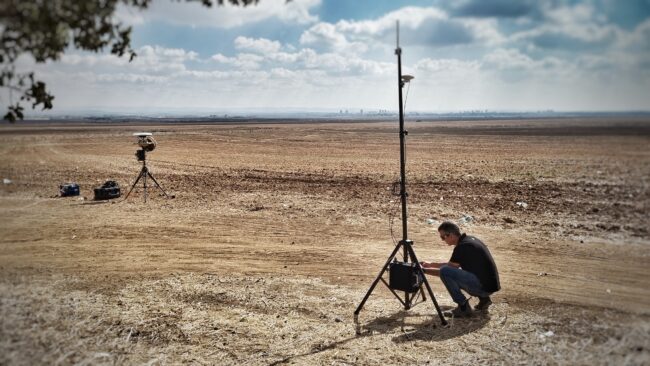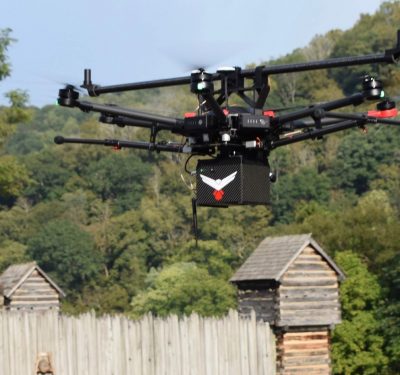
Ring’s C-UAS system from Regulus Cyber is something of a drone ringmaster. It’s impressive to watch it repel or force-land a Phantom 4, or see it simultaneously defeat a three-Mavic swarm. After its first real action in May 2021, Ring variants are being deployed in air, ground and sea environments. This may be why the company’s Ring-specific website is called counteralldrones.com.
“Ring is doing something relatively straightforward,” Regulus Cyber CEO and co-founder Yonatan Zur explained from Haifa, Israel. “Basically, the system is transmitting fake GNSS signals in a very sophisticated manner.”
How It Works
Simple yet robust, Ring is a “soft-kill” spoofing device that’s constellation-agnostic from GPS to GLONASS. “We see this as a replacement for jamming,” Zur continued. “Jamming is a brute force attack; the transmission is very strong, and you have to jam at least three channels if you want to stop it: the GNSS, the communications, the Wi-Fi and cellular. And this creates a lot of havoc in the area.”
Instead, Regulus’ “Ring Effector” system consists of an electronics box, a power source and three antennae, usually secured within a tripod.
The box, “is software,” Zur explained. “You can use it on a laptop, or with a mechanical interface. We also have an option for what we call ‘Red Buttons’—you just need to flip a switch. We integrate with radar, RF detection, and command and control systems.”
As for the antennae, one is for receiving and two others transmit GPS L1 and L2 signals. Ring’s point of difference involves using very low-power, smart RF transmission on the GNSS channel to manipulate encroaching foes. “Fifteen DBM is the maximum power we’ll use; this is about 10,000 times less than jamming—it’s less than your home Wi-Fi,” Zur said. “And by using this very low power, we achieve several effects.
“One, we do not need to jam or interfere with other communication channels; users can use radios and everything. Secondly, unlike jamming, we get control over the drone. If we are in a certain location and time, we know exactly what satellites are in the sky—GLONASS, GPS. We basically mimic the situation and transmit that against the threat. We keep feeding it with fake GPS locations. The drone or system that is being countered is taking our signal and using it, and from this point, we can play with it, start moving it around, sending it to other locations. We can crash the drone if we give it a very strong attack.”
Purpose-Deployed
Zur allowed that other c-UAS systems are available, using other technologies. But his experience as a Black Hawk helicopter pilot and with other Israeli companies has influenced Ring’s development. “I think our uniqueness is that we are really geared for military and high-end homeland security operations. This is not a system for a baseball stadium; it’s a system for battle. You can’t have a drone penetrate and you don’t have time. You need a very simple. solution—you can just use the button—and it is really stopping everything.”
There’s no need to reverse-engineer drone protocols, no dependency on whitelists, and the system has been tested against more than 30 platforms. “We don’t need to know what drone is coming at us. We don’t care how many drones are in the effective area.” Or what type: “We stopped 17 autonomous boats with the same system.”
Several variations use the same box to flesh out the Regulus armory.
• The Ring Stand-Alone protects smaller installations and can be deployed in 10 minutes.
• The Matrix defends larger areas from intrusion. “We take several Rings and they know how to communicate with each other, usually with directional antennas facing outward. Still the same box, but several boxes working together.”
• Ring ARM-V is a ground system that’s automated up to the end user. “It’s still the same box; here we use a different container and user interface,” Zur said. “It’s called ARM-V because we use a specific way of working with armored vehicles. There’s very good top protection to reach up to 15,000 feet if you put it on maximum power. On the sides, we only give around 100 to 150 meters, so we do not create too much [signal] havoc.” ARM-V has been installed for evaluation on a leading Western army’s armored vehicles.
• As of Q3 of this year, the R1 tactical-capability add-on will expand the detection range up to 1.5 km, with fast scanning of the RF spectrum and threat alerts based on profile matches. It will be able to operate BVLOS, and in bad weather or low-visibility conditions.
• Also imminent is a software-only, pre-installed or upgraded threat “detect and defeat” capability. “The only difference is the addition of another antenna, which is giving us the ability to suggest a full solution that includes around 1 kilometer of detection.”
What’s Next?
Regulus aims to have its system become the spoofer of choice for integrators. The war in Ukraine has demonstrated the importance of protecting tanks. And, while Ring is man-portable at 6 kilograms, a lighter and smaller solution is being worked up.
So far, the system has been proven in various deployments, though in small numbers. Consequently, Zur hopes 2023 will be the time when scale kicks in. “Our strategic direction is toward those big military defense projects—put it on tanks, put it on navy bases, things that are big. This is what we’re going to focus mainly on because I think that’s our edge.” At least two nations are currently engaging Ring at various levels of deployment.
That said, Regulus doesn’t rule out “selling small quantities of systems for smaller countries, places that just need something ad hoc.
“It takes time,” Zur concluded about scaling Ring. “Firstly, by one system, then 10 systems. At the end of the 10-system phase, we want to get to, ‘They buy 300 systems.’”






